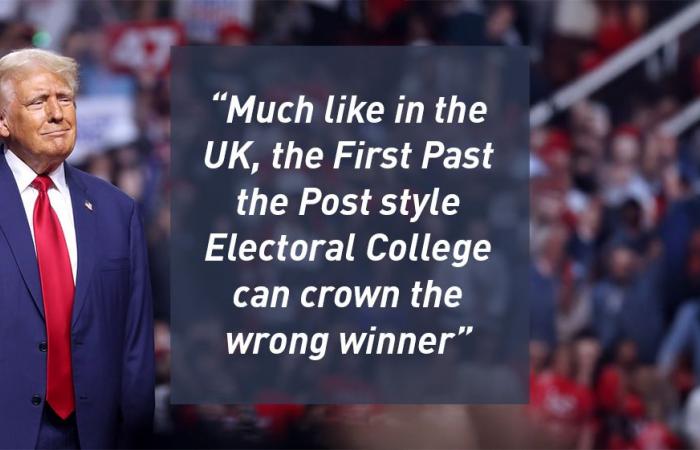
Before the last US Presidential election, in 2020, we asked whether it was possible for Donald Trump to again lose the popular vote but win the Presidency, as he had done in 2016. Although this did not happen, with Joe Biden winning the popular vote and the Presidency, after the election we explored how close a ‘wrong winner’ election had been to happening again.
The answer was… pretty close, actually. In 2020, Biden’s margin of victory over Trump in the nationwide popular vote was 4.4% (51.3% vs 46.9%). However, his margin of victory in the ‘tipping point state’, Wisconsin, the state that put Biden across the line in the Electoral College vote, which decides who wins the Presidency, was a much narrower 0.6% (49.4% vs 48.8%). Biden also won Arizona and Georgia by even more wafer-thin margins of 0.4% and 0.3%.
The Electoral College system clearly continued to skew in Trump’s favour
In 2016, Trump got 3 million fewer votes than Hillary Clinton but became President. In 2020, Trump got 7 million fewer votes than Joe Biden but lost the crucial ‘tipping point state’ of Wisconsin by just 20,000 votes. Biden did manage to increase his Electoral College victory by winning a further two states by even narrower margins, Arizona by 0.3% (49.4% vs 49.1%) and Georgia by 0.2% (49.5% vs 49.3%).
However, these results make it clear that under the current system, it is perfectly plausible that a US Presidential candidate could receive over half the votes cast, yet still not win the election.
Given that nationwide polls and those in key swing states show a very close race between Trump and Vice President Kamala Harris, it is sensible to ask a similar question to that which we posed four years ago…
Could Trump lose the popular vote for the third time but secure a second term as President?
The reason that this might be possible is the First Past the Post style Electoral College, the system that is used to elect the President of the United States.
In almost all countries that elect an executive president, the people vote for the president directly, often with some sort of mechanism to stop candidates winning on low shares of the vote. For example, in France, people vote for a candidate and, if none win a majority, the top two go through to a second round. The one with the most votes across the country, usually in this second-round run-off between the top two candidates from the first round, wins.
In the US, this is not the case. Under the Electoral College system, each state (plus the District of Columbia) is allocated a number of Electoral College votes, roughly in proportion to their population, but weighed towards the smaller states. The number of Electoral College votes varies from 54 for California to three each for Alaska, Delaware, District of Columbia, North Dakota, South Dakota, Vermont and Wyoming. Wyoming has one electoral college vote for every 195,000 people, while Texas, Florida and California have one per roughly 700,000. A candidate needs 270 Electoral College votes to win the Presidency.
Amazingly, the fact that each voter isn’t equal isn’t even the root of the problem.
The vast majority of states apply a winner-takes-all system, whereby the candidate who wins the most votes in a state are assigned all of that state’s Electoral College votes. The exceptions are Maine, which assigns two of its four Electoral College votes to the winning candidate in each of its congressional districts and Nebraska, which assigns three of its five Electoral College votes to the winning candidate in each of its congressional districts.
This first past the post style system means it doesn’t matter whether a candidate wins 51-49 or 80-20, in nearly every state they will win every Electoral College vote that state has.
Like First Past the Post, the Electoral College can crown the wrong winner
A closer look at three states, in the Great Lakes region of the US, which were crucial in both the 2016 and 2020 election and are likely to be crucial again in 2024, indicate how the Electoral College can produce ‘wrong winner’ outcomes.
These three states are Pennsylvania (19 Electoral College votes), Michigan (15 Electoral College votes) and Wisconsin (10 Electoral College votes). Prior to Trump’s 2016 victory these states had voted for the Democratic candidate in every Presidential election since 1992 (Michigan and Pennsylvania) or 1988 (Wisconsin). In 2016, Trump was able to outperform his nationwide popular vote performance in these three states and flip them in his favour, winning each of them by wafer-thin margins of less than one percentage point. If Clinton had managed to keep these states in her column, she would have become President. However, she lost them, which meant the fact she received 3 million more votes than Trump across the United States as a whole, counted for nothing.
In 2020, Biden was able to win each of these seats back from Trump, thereby regaining the White House for the Democrats. However, in each of these states, Biden’s victory margin was narrower than his overall victory margin over Trump (4.4%) – Wisconsin (0.6%); Pennsylvania (1.2%); Michigan (2.8%).
So much rests on a handful of swing states, such as these three, which mean big changes in support in other parts of the country can count for nothing. For example, in California, Joe Biden’s majority over Trump was 5.1 million votes, a large increase on Clinton’s majority over Trump, which was 4.3 million votes. However, this big swing counted for nothing as it occurred in a ‘safe’ Democratic state, where the Electoral College votes were already tied up for Biden and it was impossible to gain any extra Electoral College voters from this increase in support.
This has strong echoes of the First-Past-The-Post (FPTP) electoral system, that is used for UK general elections. It’s clear why in both FPTP and the Electoral College the vast majority of campaigning is targeted in swing states or seats, with vast swathes of both the UK and US, which are regarded as ‘safe’ for one party or another, ignored.
In a democracy, the location of your voters shouldn’t be more important than their number. Sadly, under systems like the Electoral College, the democratic will of the people, clearly expressed, can be overruled by the arbitrary geographic rules of ‘winner’ takes all.
The National Popular Vote Compact
The National Popular Vote Compact is a movement for electoral reform in the US. Seventeen states, plus the District of Columbia have enacted the Compact into law, the most recent being Maine in April 2024. The law would see the Electoral College votes of these states go to the winner of the national popular vote. However, it needs states with a total of 270 Electoral College votes, enough to win the Presidency and it is still 61 Electoral College votes short of the target. All of the states that have signed up are reliably Democrat-voting states at the Presidential level.
At the moment there does not appear to be any appetite among the Republican Party to consider reform of the Electoral College system. However, a recent article posited a scenario that could change that – Trump winning the popular vote but losing the Electoral College. This seems unlikely, given that the Democrats have won the popular vote in five out of the last six presidential elections and Trump has not got more than 47% of votes in either of his previous two Presidential runs. However, it will probably take this or something similarly seismic, such as the Republicans losing Texas and its 40 Electoral College votes (which is a possibility at some point, given the state has been trending towards the Democrats in recent years), for Electoral College reform to become a truly bipartisan issue.
Does the idea of millions of voters being ignored make you angry?
Join our fight for fair elections. Members support our work in parliament, in the press and online – making the case, and backing it up – for how we can fix Westminster’s broken system.
Join the Electoral Reform Society today





